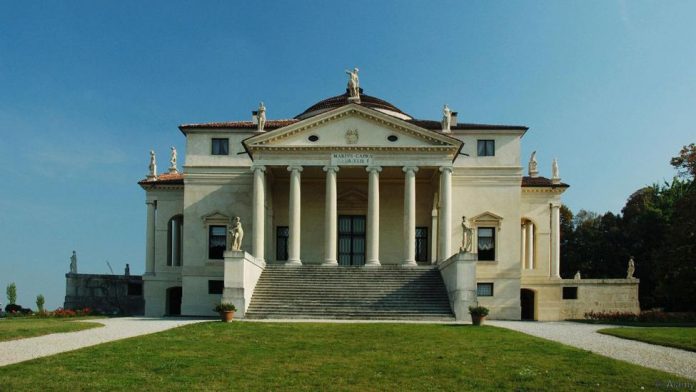In 1565, Paolo Almerico, a high-ranking official in the Papal courts of Pius IV and V, retired from the Vatican to Vicenza, in northeast Italy. Here he commissioned Andrea Palladio, one of history’s greatest architects, to design a new type of house. Built on a hill overlooking the city and surrounding countryside, La Rotonda was a freestanding villa independent of agriculture, religion or commerce. A place of study, contemplation and quiet enjoyment, it was also a work of impeccable art.
Neither patron nor architect lived to see La Rotonda completed. Here, though, a thing of beauty was indeed a joy forever. Serene, symmetrical, laced with subtle religious symbolism – its plan a cross set within a square within an imaginary circle – and with classical Ionic porticos facing all four cardinal points of the compass, this exquisite house connected landscape to city while fusing art to architecture. Here was a Renaissance ideal made perfectly real.

Serene, symmetrical, laced with subtle religious symbolism – La Rotonda is an impeccable work of art (Credit: Alamy)
Ever since, and in no matter what style, material or culture, certain architects and enlightened or excitable patrons have aimed to do more or less what Palladio and Almerico did 450 years ago. A new exhibition at New York’s MoMA, Endless House: Intersections of Art and Architecture, “considers the single-family home and archetypes of dwelling as themes for the creative endeavours of architects and artists”.
Through engaging drawings, models, videos and installations, the show investigates the house as a means to explore architectural ideas that dovetail with the concerns of art. It also looks at the work of artists who have made the house a focus of their creativity, and by implication it raises the question admirably answered by Palladio and Paulo Almerico: can the house be a work of art?
The question is timely given that the problem of housing the world’s rapidly growing population has led to intense suburban sprawl along with the spread of shantytowns – not to mention homes and houses, whether cheap or costly, that are as far from art as the hillside favelas of Rio de Janeiro are from the salubriously populated slopes of Vicenza.
‘Ghosts in the house’
MoMA’s show focuses on the fusion of art and architecture over the past fifty years, rather than the previous 500. This is because this year is the 50th anniversary of the death of Frederick Kiesler, a visionary Austrian-American artist and architect, who worked closely with the museum in the late 1950s on a project for a house as radical as La Rotonda had been in the 1560s. This was the Endless House. It was only ever realised as a model, but what an extraordinary, mind-expanding thing it was, a flattened, organic spheroid containing free-flowing interior spaces expressing what Kiesler called Correalism, a design philosophy concerned with shaping a continuity of spaces, people, objects, concepts and art.
If this all sounds very ‘60s, in a way it was. Correalism and the Endless House were to influence architects like Frank Gehry, who in 1998 was the first recipient of the Frederick Kiesler Prize for Architecture and Art. Gehry’s epochal Guggenheim Bilbao museum had opened the previous year sealing the restlessly inventive Californian architect’s reputation in flowing folds of dazzling titanium. Twenty years earlier, Gehry had bought a modest Dutch Colonial-style house dating from 1920 in Santa Monica, conjuring it into a magical family home, all curious angles, workaday materials and, yes, a continuity (and fragmentation) of space, objects, concepts and art.

Frank Gehry’s transformed Dutch Colonial-style house that is now an eclectic family home (Credit: Corbis)
“We were told there were ghosts in the house”, Gehry told Arch Daily. “I decided they were ghosts of Cubism. The windows… I wanted to make them look like they were crawling out of this thing. At night, because this glass is tipped it mirrors the light in… so when you’re sitting at this table you see all these cars going by, you see the moon in the wrong place… the moon is over there but it reflects here… and you think it’s up there and you don’t know where the hell you are.”
Frederick Kiesler would have enjoyed visiting Frank Gehry in this house that doubles as a work of enjoyably unsettling art. When asked to build a full-scale mock-up of the Endless House in MoMa’s courtyard for the museum’s 1960 show Visionary Architecture, Kiesler talked about floors of pebbles, sand, grass, planks, of rivulets of water and heated terracotta tiles. It was never built.

A beautiful scale model of Wing House by Asymptote Architecture (Credit: Asymptote Architecture)
Nor was the Wing House by Asymptote Architecture, a New York practice founded by Hani Rashid and Lise Anne Couture. This was one of Three Houses for the Sub-Conscious shown in the form of exquisite scale models at the 2008 Venice Architecture Biennale. MoMA has a paper, cardboard, acrylic and polystyrene model of the Wing House revealing an interior as smooth flowing and as adventurous as Kiesler’s Endless House. Perhaps, not surprisingly, Aysmptote are among winners of the Frederick Kiesler Prize.
Natural habitat
Such designs are explorations of ideas connecting art and science to architecture. In 2006, Gillian Lambert, a London architectural student, brought weather into the mix. Her beautiful drawings for a “studio house for a weather-obsessed architect” were, she told me, inspired by JMW Turner’s sensational painting Snow Storm – Steam-Boat Off a Harbour’s Mouth,from 1842. Ideally set by the River Thames, “the spaces within the house are blurred as rain falls from the ceiling into a well below; the breeze in the air is filtered through the walls, through pockets of bright daylight and areas hidden within dark shadows. The interiors reflect the unpredictable and dynamic nature of external conditions.”

Gillian Lambert’s creation was inspired by JMW Turner’s painting Snow Storm – Steam-Boat Off a Harbour’s Mouth (Credit: Gillian Lambert)
If very different from Gehry’s “ghost of Cubism”, Lambert’s project exhibited a haunting presence as did Edo Architecture’s tantalising Ghost of Water Row, a house made of pale Scottish spruce with white cotton roof and walls that stood, lit translucently, on the banks of the Clyde in Glasgow for one night only in November 2012. Created by Edo Architecture (Andy McAvoy and Ann Nisbet), it was an ethereal evocation of one of the row of weavers’ houses that stood here from 1790 to 1929 before weaving gave way to shipbuilding that, in turn, is a ghost of its former self today.

Ghost of Water Row on the banks of the Clyde in Glasgow, is a new take on the weavers cottages that once stood on the site (Credit: Alamy)
The Turner Prize winning artist Rachel Whiteread did something similar in the 1990s, first with Ghost (1990), a plaster cast of the interior of a Victorian house and then with House (1993), an ambitious and compelling concrete cast of the inside of an entire three-storey East London house, damaged during the Blitz. Although only meant to be temporary, House wowed critics and won Whiteread the Turner Prize. On display in a public park, the local council demolished the cast with uncontained glee.
Modern architects, meanwhile, notably Le Corbusier and Mies van der Rohe, had created houses as artworks that brought Palladio and Paolo Almerico’s ideal into the 20th Century and beyond. Whether experimental, conceptual and ghostly or architecturally formal and correct, key buildings and artworks reflecting on the nature of the house have tried hard over the centuries to lift our minds and focus our eyes on something so very much higher than the rash of artless new housing blighting the world today.










